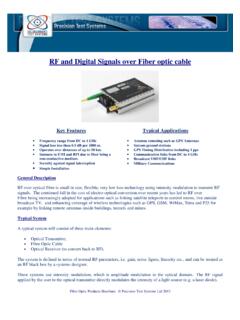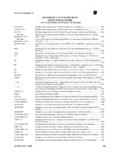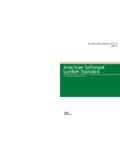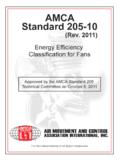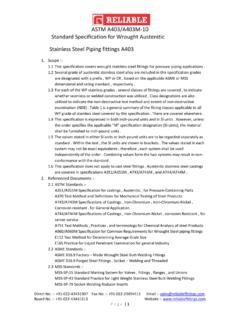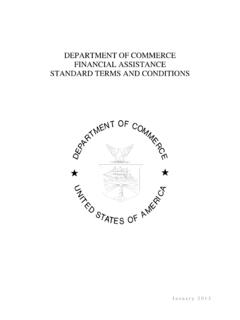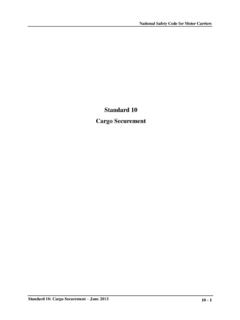Transcription of GPS10RBN: 10 MHz, GPS Disciplined, Rubidium Frequency …
1 GPS10 RBN Brochure. Precision Test Systems Ltd 1997 - 2016 GPS10 RBN: 10 MHz, GPS disciplined , Rubidium Frequency Standard Key Features Completely self-contained unit. No extra needed. Full information available via LCD. Rubidium Oscillator locked to GPS satellite signal. Accuracy to parts in 10-13 (Stratum 1 performance) Free run mode. Rubidium still gives an accurate output without a GPS satellite signal (Stratum 1) Two 1 pps time outputs. Typical error < 20 ns compared to UTC. Jitter < 300 ps Low Phase Noise, -135 dBc/Hz at 10Hz Multiple 10 MHz Outputs plus other outputs Windows software with full control and monitoring of the GPS10 RBN via RS232, USB, Ethernet or the web. 19 2U high rack mountable case. Very Low Microphonics Many options. See list of options in this brochure. Custom built options available upon request High quality design General Description The GPS10 RBN is a 10 MHz, GPS disciplined , ultra low phase noise, Rubidium Frequency standard.
2 It combines the short-term stability of an atomic Rubidium oscillator with the long-term stability and traceability of the Global Positioning Service (GPS) set of satellites. The GPS10 RBN achieves short and long-term Frequency accuracy of parts in 10-13. Thus the GPS10 RBN exceeds the requirements of a Stratum 1 level Frequency standard. Options for the GPS10 RBN include 5 to 20 isolated sinewave outputs, an antenna amplifier or fiber optic GPS link, enabling the antenna to be placed up to 1 km from the GPS10 RBN, various fixed high Frequency outputs, alarm relay outputs, redundancy, battery backup supply, time code outputs and a variable Frequency output. GPS10 RBN Brochure. Precision Test Systems Ltd 1997 - 2016 Ultra Low Phase Noise The GPS10 RBN has very low phase noise. Phase noise is typically -95 dBc/Hz at a 1 Hz offset with a -162 dBc/Hz noise floor.
3 Low phase noise is a very important parameter. A typical plot of the phase noise is shown below. This phase noise can even be improved further with the ultra low phase noise option (option 26). Allen Deviation Below is a plot of the Allen deviation. Typical Allen deviation is < 2 x 10-11 at 1 second dropping to less than 1 x 10-13 at 1 day. Even lower Allen Deviations are available. Contact Precision Test for details. GPS10 RBN Brochure. Precision Test Systems Ltd 1997 - 2016 Accurate Timing Outputs There are two 1 pps (pulse per second) outputs that are derived from the GPS receiver or the Rubidium oscillator. The leading edge of the GPS 1 pps signal is aligned to UTC time 20 ns. The Rb 1 pps output signal has very low jitter of < 300 ps. These outputs can drive TTL levels into 50 . Keyboard Control and LCD Display A 16-way keyboard is used to interface to three microprocessors that control the GPS10 RBN.
4 The LCD display's over 50 different menus. These menus show all the relevant information including time, position (longitude, latitude, height), number of satellite tracked, health of each satellite and the status of the Rubidium oscillator. Multiple Frequency Outputs The GPS10 RBN has many different output options. These outputs are: Buffered 10 MHz sinewave outputs. Each output is fully isolated from each other. The amplitude of each output can be individually adjusted from 0 dBm to +13 dBm. Reverse isolation of each output is 130 dB and channel to channel isolation is typically 90 dB. Five outputs as standard. Up to 20 outputs can be optionally installed. Optional output level to +20 dBm is available. By connecting more distribution amplifiers, up to 1000 outputs can be realized, all delivering a low phase noise output. Optional square wave output that can drive TTL levels into a 50 load impedance.
5 The Frequency of the square wave can be set to 10, 5, 2, 1, MHz and 1 pps via the front panel keyboard. Dual one pulse per second outputs aligned to UTC, as mentioned above. Optional high Frequency outputs can be specified at the time of ordering. These fixed high Frequency outputs can be as high at 10 GHz (higher frequencies available upon special request) and are phase locked to the main Frequency reference. Note: this option only generates one fixed Frequency . Optional DDS Output enables the GPS10 RBN to produce a sinewave and squarewave output that is locked to the GPS10 RBN. The Frequency range of this output is 1 Hz to 80 MHz (1 Hz steps). 10 Hz to 1640 MHz (10 Hz steps). This option can be used to generate the popular 2048 kHz and 13 MHz frequencies as well as any Frequency in the range 1 Hz to 80 MHz or 10 Hz to 1640 MHz. Optional Time Code Output.
6 This option generates the industry standard IRIG-B, IRIG-E, SMPTE, NTP etc. Also a 48 bit BCD time code can be generated with option 16. Free Run Mode. Ideal for portable applications The GPS10 RBN is normally operated with the Rubidium oscillator's 10 MHz output, locked to the GPS satellite system. In the event of a failure of the GPS signal for any reason, the GPS10 RBN will automatically switch over to free run mode. In this mode, the GPS10 RBN's Rubidium Oscillator still achieves Stratum 1 performance over a 72 hour period. Also the GPS10 RBN can be used for portable applications where a satellite signal is not available, or the time required to lock the GPS10 RBN is not available. When the GPS10 RBN is powered up it can be set to the free run mode. The Rubidium Oscillator "remembers" the last known good Frequency setting and adjusts itself to this Frequency .
7 Thus an accurate 10 MHz is available within a few minutes of switch on. This mode is ideal for setting up GSM base stations that require an accurate time base for Frequency measurement. GPS10 RBN Brochure. Precision Test Systems Ltd 1997 - 2016 RS232 and Optional Interfaces The RS232 interface allows complete control and interrogation of the GPS10 RBN. Optional USB or Ethernet adapters allows the GPS10 RBN to be controlled via the USB port of the PC or from a network. GPS10 RBN Rear panel Options The GPS10 RBN has many options enabling it to work in varied applications. Not all options can be installed at the same time. Some options require a separate case. Some of the options are listed below: Option 01 and 02: Second Frequency Output, 0 to 500 MHz spot Frequency and 500 to 1 GHz spot Frequency This option gives a second Frequency output.
8 The Frequency is fixed and cannot be changed. The spot Frequency must be advised by the customer prior to manufacture. The Frequency can be in the range 0 to 1 GHz. Some examples are shown below: 01A 500 MHz Square x 1 01E MHz Sine x 5 01J 5 MHz Sine x 5 01N 5 MHz Sine ULN 01B 100 MHz Sine x 1 01F MHz Sine x 5 01K 1 MHz Sine x 5 01P 75 MHz Sine ULN 01C MHz Sine x5 01G 100 MHz Sine ULN 01L 100 kHz Sine x 5 01R 13 MHz Sine ULN 01D MHz Sine x 1 01H 16 MHz Sine ULN 01M 5 MHz x 5 LN 01U 50 MHz Sine x 5 Option 02 Aand option 02B. : Second Variable Frequency Output, 780 to 820 MHz or 800 to 1200 MHz. This option gives a second Frequency output. The Frequency is variable and can be changed from 780 MHz to 820 MHz or 800 - 1200 MHz in 100 kHz steps. The Frequency output has good phase noise and low spurious. Option 03: Second Frequency Output, 1 GHz to GHz spot Frequency This option gives a second Frequency output.
9 The Frequency is fixed and cannot be changed. The spot Frequency must be advised by the customer prior to manufacture. The Frequency can be in the range 1 GHz to GHz. Option 03A: Second Variable Frequency Output, GHz to GHz This option gives a second Frequency output. The Frequency is variable and can be changed from GHz to GHz in 100 kHz steps. The Frequency output has good phase noise and low spurious. Option 04 and Option 35: Antenna Amplifier /Fiber Optic Link These options can be used to extend the range between the GPS antenna and the GPS10 RBN. Up to 300 m (1000 feet) can be realized with a cable and amplifier, up to 1 km (3200 feet) with a fiber optic GPS link. Option 05, 05A and 05B: DDS Signal Generator Option 05 adds a DDS (direct digital synthesis) signal output to the GPS10 RBN. The DDS output has a squarewave and sinewave output. The Frequency of this output is adjustable from 1 Hz to 80 MHz in steps of 1 Hz.
10 Option 06: RS232 Cable The RS232 cable connects the GPS10 RBN to a PC enabling control and interrogation of the GPS10 RBN. GPS10 RBN Brochure. Precision Test Systems Ltd 1997 - 2016 Option 07, 07A and 07B: Alarm Relay/TTL Output This option adds an alarm output. Option 07 and 07A add a dual changeover relay that is activated in the event of an alarm. Each relay contact is rated at 30 VDC and 1 Amp (5A for Option 07A). Option 07B is a TTL output signal only. Option 08: Redundancy Option 08 adds redundancy. With this option, two GPS10 RBN s can be configured into a redundancy set-up with five main 10 MHz outputs (up to 20 outputs optionally available). Normally one unit will supply the 10 MHz outputs (locked to the GPS satellite). In the event of failure of this unit, the 10 MHz outputs will be automatically switched to the second GPS10 RBN unit.

